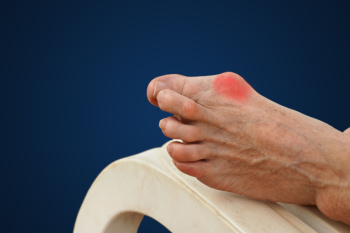
Bunions develop due to prolonged stress on the metatarsophalangeal joint, often resulting from wearing ill-fitting shoes that force the big toe inward. This pressure causes the first metatarsal to angle outward and the big toe to point in the opposite direction, forming a noticeable bump. Additionally, genetic factors, low arches, flat feet, loose joints, and arthritis can contribute to bunion formation. Narrow, pointed-toe, or high-heeled footwear, commonly worn by women, can also heighten the risk. Furthermore, running in shoes with tapered toe boxes and elevated heels may exacerbate bunions over time. Bunions can lead to pain, discomfort, and even deformities such as hammertoes or corns. Prevention strategies include wearing wide-toed shoes, avoiding high heels, using toe spacers, and performing bunion massages to alleviate symptoms and prevent further complications. If you have a painful bunion, it is suggested that you schedule an appointment with a podiatrist for an evaluation and treatment that is best for you.
If you are suffering from bunion pain, contact one of our doctors of Intercoastal Medical Group. Our doctors can provide the care you need to keep you pain-free and on your feet.
What Is a Bunion?
Bunions are painful bony bumps that usually develop on the inside of the foot at the joint of the big toe. As the deformity increases over time, it may become painful to walk and wear shoes. Women are more likely to exacerbate existing bunions since they often wear tight, narrow shoes that shift their toes together. Bunion pain can be relieved by wearing wider shoes with enough room for the toes.
Causes
- Genetics – some people inherit feet that are more prone to bunion development
- Inflammatory Conditions - rheumatoid arthritis and polio may cause bunion development
Symptoms
- Redness and inflammation
- Pain and tenderness
- Callus or corns on the bump
- Restricted motion in the big toe
In order to diagnose your bunion, your podiatrist may ask about your medical history, symptoms, and general health. Your doctor might also order an x-ray to take a closer look at your feet. Nonsurgical treatment options include orthotics, padding, icing, changes in footwear, and medication. If nonsurgical treatments don’t alleviate your bunion pain, surgery may be necessary.
If you have any questions, please feel free to contact our offices located in Bradenton, and Sarasota, FL . We offer the newest diagnostic and treatment technologies for all your foot care needs.
